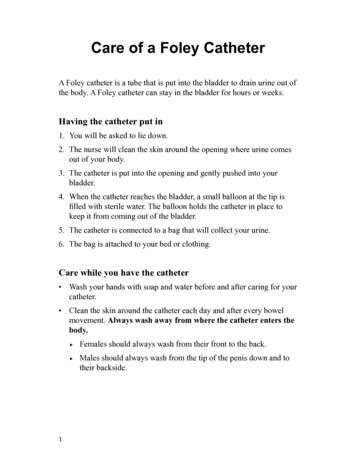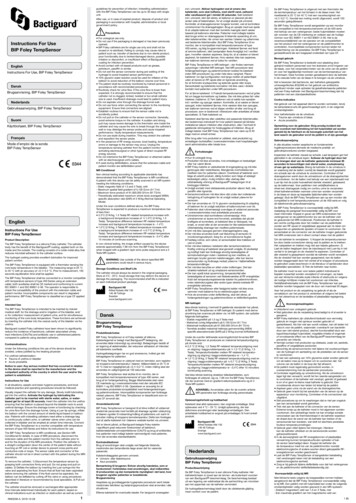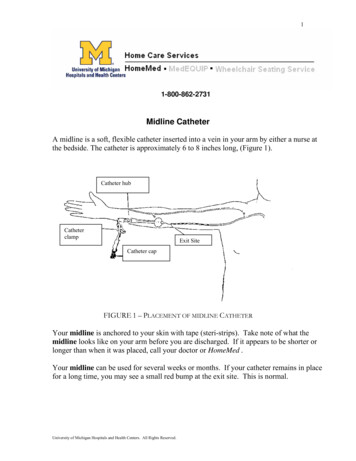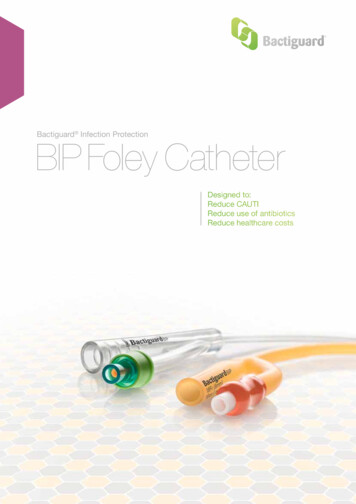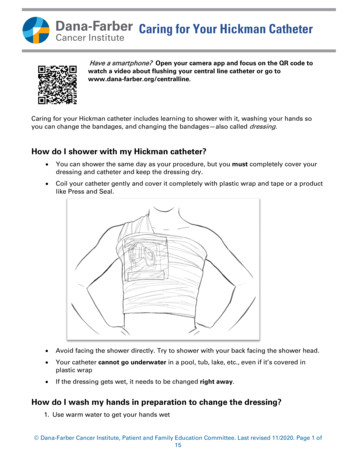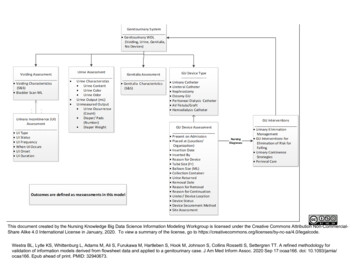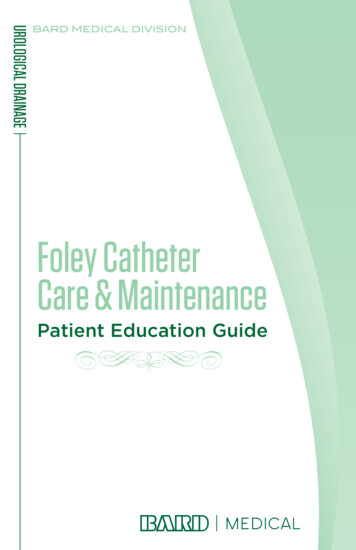
Transcription
UROLOGICAL DRAINAGEBARD MEDICAL DIVISIONFoley CatheterCare & MaintenancePatient Education Guide
UROLOGICAL DRAINAGE“WHAT IS A FOLEY CATHETER?”Because of your medical problem, your body is having troublecompletely emptying your bladder of urine. This is why your healthcareprovider has prescribed a Foley catheter. The Foley catheter will act asa drain to empty your bladder.A Foley catheter is a thin, hollow tube made of soft, flexible material. Itis passed through the urethra into the bladder.The catheter is held in place by a small water-filled balloon which isinflated in the bladder to keep the catheter from falling out while you goabout your normal activities.Urine will automatically drain out of your bladder into the bag which isattached to the catheter.A catheter drainagesystem consists of:1. A Foley catheter2. A urinarydrainage bag1.2.Catheter placement in a maleCatheter placement in a female
BARD MEDICAL DIVISION“WHAT SHOULD I DO IF ITHINK I HAVE A PROBLEM?”Talk to your healthcare provider wheneveryou have a question or think you may have aproblem. Here are some things you can do onyour own.LeakageOccasional leakage is not unusual. If it is persistentor in large amounts, call your healthcare provider.Call your healthcare provider immediately if you notice: Strong odor or cloudy urine Blood in urine Chills, fever above 99.4 degrees Lower back pain Abnormal leakage around the catheter Swelling at catheter insertion site, especially in men Disorientation or change in mental statusNo Urine In Bag Change your body position Check for kinks or loops in the catheter and tubing Make sure the bag is lower than your abdomen so urineflows freely by gravity DO NOT clamp the catheter or tubing DO NOT irrigate the catheter unless instructed by yourhealthcare provider Call your healthcare provider immediately if the above steps donot restore proper urine OLUMEml120010008006004003002001007550Avoid kinks and loops in thecatheter or tubingCall your healthcare providerabout large amounts of leakageor when you cannot restore urineflow
UROLOGICAL DRAINAGE“HOW DO I CARE FOR MY FOLEY CATHETER”It is important to follow a few simple guidelines to avoid possiblecomplications with your Foley catheter.1. Maintain a Closed Drainage SystemMaintaining a “closed” drainage system reduces the numberof bacteria that enter the catheter system to cause aninfection.In order to maintain a closed drainage system: DO NOT remove the catheter unless instructed by yourhealthcare provider. DO NOT handle the catheter, tubing, or drainage bagwithout first washing your hands with soap and water. DO NOT break the connection from the catheter and thetubing. If a disconnection accidentally occurs, clean both endswith an alcohol pad, reconnect immediately, and call yourhealthcare provider.2. Use a Foley stabilization deviceFoley catheters are often subject to inadvertent pullingforces that can lead to discomfort. A Foley stabilizationdevice is designed to minimize catheter movement andaccidental dislodgement, thereby maximizing comfort.
BARD MEDICAL DIVISION3. Maintain a Steady Urine Flow Keep the drainage bag below thelevel of your lower abdomen at alltimes, to keep urine flowing freely bygravity. Make sure there are no kinks or loopsin the catheter or tubing which mightrestrict urine flow. Empty the drainage bag every four toeight hours, or if it becomes filled beforethen. DO NOT let the drain tube touch thecontainer the urine is draining into, whenemptying the bag.ATEOXIMAPPR LUMEVOml20001800160014001200LUX-REFANTI AMBERCH100080060040030020010075504. Practice Good HygieneWash hands with soap and water before and after touchingthe catheter or drainage bag. Wash skin around the catheterwith soap and water daily and after each bowel movement.This will help reduce the risk of infection.
UROLOGICAL DRAINAGE“HOW CAN I PREVENT PROBLEMS WITH MYFOLEY CATHETER?”The Foley catheter is a necessary aid for managing your urinarydrainage. With proper management and care, most potentialproblems with your Foley catheter can be avoided.1. Drink Plenty Of FluidsUnless your doctor has prescribed otherwise, drink at leasteight to ten 8 ounce glasses of liquids daily. This helpsreduce buildup of deposits that may block the catheter fromdraining properly.2. Maintain Steady Urine FlowKeeping the drain bag below bladder level at all times andfree of kinks and loops allows urine to drain in a “downhill”direction.Urine backing up or stagnating in the tube or bag can leadto infection.Empty your drainage bag every 4-8 hours or morefrequently if it becomes filled before then.3. Practice Good HygieneWash hands with soap and water before and after touchingthe catheter or drainage bag. Wash skin around the catheterwith soap and water daily and after each bowel movement.This will help reduce the risk of infection.
BARD MEDICAL DIVISION4. Maintain a Closed Drainage SystemMaintaining a “closed” drainagesystem reduces the number of bacteriathat enter the catheter system to causean infection.In order to maintain a closed drainagesystem: DO NOT remove the catheter unlessinstructed by your healthcare provider. DO NOT handle the catheter, tubing, ordrainage bag without first washing yourhands with soap and water. DO NOT break the connection from thecatheter and the tubing. If a disconnection accidentally occurs, cleanboth ends with an alcohol pad, reconnectimmediately, and call your healthcare provider.5. Talk to Your Healthcare providerYour healthcare provider will use the smallestcatheter and balloon possible. A larger cathetermay cause problems and will not drain urine anyfaster.Wash hands with soap andwater before and after touchingthe catheter or drainage bag
UROLOGICAL DRAINAGE“HOW DO I APPLY, MAINTAIN AND REMOVE ASTATLOCK FOLEY STABILIZATION DEVICE?”Application TechniquePrep1. P lace Foley catheter into retainer.Directional arrow should pointtowards catheter tip, and the ballooninflation arm should be next to theclamp hinge.2. Close lid by placing your fingersunder the pad and pressing the gripmarkers at the end of the clamp withyour thumb, being careful to avoidpinching the catheter.3. Identify proper securement siteby gently laying the StatLock Stabilization Device straight on thefront of the thigh, then back up oneinch towards the insertion site.* Makesure leg is fully extended. – Gently place the StatLock Stabilization Device off to the side,away from the selected securementsite.4. Cleanse and degrease securementsite with alcohol. Let skin dry.Be sure to clean area larger thansecurement site.5. Apply skin protectant using bothpads, in direction of hair growth,to area larger than securementsite. Allow to dry completely (10-15seconds).1236. Using permanent marker, write initialsand date of application on StatLock anchor pad. OTE: Always secureNcatheter into the StatLock Stabilization Device retainerBEFORE applying adhesivepad on skin.4, 56
BARD MEDICAL DIVISIONPlace and Peel7. Align the StatLock Stabilization Deviceover securement site, leaving one inchof catheter slack between insertion siteand the StatLock Stabilization Deviceretainer.* Make sure leg is fully extended.78. While holding the retainer to keep thepad in place, peel away paper backing,one side at a time, and place tension-freeon skin.8Removal TechniqueDisengage1. O pen retainer by pressing release buttonwith thumb, then gently lift to open.2. Remove Foley catheter.Dissolve13. Wipe the edge of the pad using at least5-6 alcohol pads until a corner lifts.Then continue to stroke undersurfaceof pad, in a back-and-forth motion, bysqueezing the alcohol out to dissolve theadhesive pad away from the skin.2 o not pull or force pad toDremove.3
UROLOGICAL DRAINAGEnotes* For long-term male Foley catheter users, ideal location for stabilizationis the abdomen to prevent meatal damage and erosion. StatLock devicesshould be monitored daily and replaced when clinically indicated, at leastevery 7 days. Catheter insertion site should be treated per establishedhospital policy and procedure. StatLock devices are contraindicatedon patients with known tape or adhesive allergies. Please consultproduct inserts and labels for any indications, contraindications, hazards,warnings, cautions and directions for use. StatLock devices are sterile andlatex-free.
BARD MEDICAL DIVISIONSummary of Indications, Warnings, Precautions and Contraindicationsfor Foley Catheters: Foley catheters are intended to be used to drainurine from the bladder. Catheters may contain natural rubber latexwhich may cause allergic reaction. The most common risk is urinarytract infection. Please consult product labels and inserts for moreproduct information.
UROLOGICAL DRAINAGEBARD MEDICAL DIVISIONFoley CatheterCare & MaintenancePatient Education GuideC. R. Bard, Inc.8195 Industrial BoulevardCovington, Georgia 30014800.526.4455 Fax: 800.852.1339www.bardmedical.comBard and StatLock are registered trademarks of C. R. Bard, Inc. Copyright 2013 C. R. Bard, Inc. All rights reserved.1310-61 R11/13 THP P12/13 2.5M
inflated in the bladder to keep the catheter from falling out while you go about your normal activities. Urine will automatically drain out of your bladder into the bag which is attached to the catheter. A catheter drainage system consists of: 1. A Foley catheter 2. A urinary drainage bag Catheter placement in a male Catheter placement in a .
